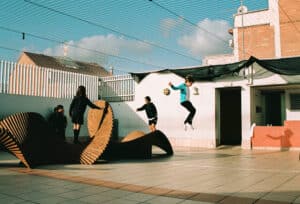It seems we can’t find what you’re looking for. Perhaps searching can help.
Design and construction of public furniture installations for school-children on the schoolyard terraces of the Colegi Mare de Déu dels Angels. Construction-oriented design that considers stakeholder engagement strategies, with a focus on conscious material use, child-safe performance and long-lasting results. Design of schoolyard public space installation geared towards user-centric design, using digital tools and fabrication systems.
Syllabus

This is a design course developed to offer a design through implementation skills-building experience of a small-scale furniture project while incorporating client expectations and direct end-user considerations. The instructor will act as a mentor throughout the course, helping students to navigate various complexities related to:
- Establishing participatory design methods
- Developing a design language from diverse inputs and concerns
- Finding creative solutions with limited resources
- Curating client facing experiences
- Providing direction during the construction process
The course explores how the use of digital tools and technologies can benefit communities and how creative problem-solving and co-design strategies can result in transformative spaces for children and their caregivers. In addition, the course provides an opportunity for exploration and discovery of materiality, wood fabrication and construction details of industrial quality that will act as a foundational exercise for detailing and constructing the MAEBB 25/26 final project.
Site and Program:
The site of the furniture installations are the terraces of the Colegi Mare de Déu dels Angels. This institution comprises 3 schools: Kindergarten, primary and secondary schools. Students will form 3 teams and choose 1 school as their site/client of choice. The choice of the specific terrace to be outfitted with a furniture installation will first be requested from the administrative body and if no preference is given, MAEBB students are allowed to select the terrace that they deam best fits their aspirations. The specific design brief must be collected from each school’s administrative representative. However, a broad design scope includes a furniture installation that accommodates user-specific needs related to leisure, relaxation and recreation as well as the potential for creating or expanding natural and green elements into the terrace environments.
Course Intent:
Design and implementation of furniture installations with long-lasting, industrial quality, high performance standards and low maintenance requirements. The installations are intended to be curated to the specific behaviors and needs of end-users as well as meet client expectations and functional goals for the administrative board of the Colegi Mare de Déu dels Angels.
Course Objectives:
Students completing the studio are expected to achieve the following:
- Develop opportunities for meaningful and constructive community engagement during the design process
- Ability to gather qualitative data from stakeholders that informs design decisions
- An ability to develop a technical design language that systematically incorporates diverse design concerns and can be applied in the context of a public space design project in a cohesive and logical way.
- Design decisions that address environmental issues, limited resources and lack of budget without compromising design objectives and values
- Design creativity and problem-solving that is sensitive to community needs and offers authorship and ownership to stakeholders as much as possible
Learning Methodology:
As an advanced design seminar, this is a learning-by-doing course wherein students will propose comprehensive design decisions that are both human-centric and environmentally conscious. The format encourages students to develop robust technical skills while learning strategies for stakeholder engagement and participation during the design process. Students will learn how to encourage stakeholder involvement and decision-making while translating concerns or expectations into a design vocabulary that can be controlled and developed. Students will present their work directly to stakeholders. Presentations and discussions will provide context for course requirements and expectations. Desk crits, group discussions and critiques will be conducted during most sessions.




